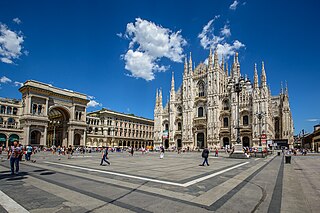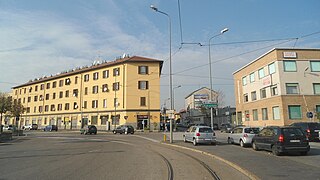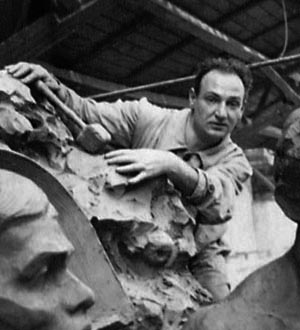History
In the 19th century, as a consequence of the rapid demographic growth of Milan, a thorough reorganization of the cemeteries of the city was due. At the time, Milan had a large number of small cemeteries located in areas that were originally peripheral but, as the city expanded, had experienced a quick urbanization. Plans were made to close down most of these small cemeteries and build a few, larger ones, in the outskirts of the city. The Monumentale was built first (in the early decades of the century), but it soon became clear that at least another large cemetery was needed. Core samples proved that the rural area of Musocco, bordering on Milan, had suitable geological properties; after some quarrel with Musocco's administration, construction began in the late 19th century, on a design by architects Luigi Mazzocchi and Enrico Brotti. The cemetery opened in 1895; [2] it originally covered an area of 400,000 m2.
Graves from at least four different cemeteries were moved to the Maggiore. A dedicated tram was employed to move the graves; it is said that the people of Milan nicknamed this tram "La Gioconda" ("the joyful one"). [2]
Benito Mussolini was buried in an unmarked grave in the Maggiore immediately after his death, although his corpse was later moved, to be eventually buried again in his hometown Predappio.

Piazza del Duomo is the main piazza of Milan, Italy. It is named after, and dominated by, Milan Cathedral. The piazza marks the center of the city, both in a geographic sense and because of its importance from an artistic, cultural, and social point of view. Rectangular in shape, with an overall area of 17,000 m2, the piazza includes some of the most important buildings of Milan, as well some of the most prestigious commercial activities, and it is by far the foremost tourist attraction of the city.

The Cimitero monumentale di Staglieno is an extensive monumental cemetery located on a hillside in the district of Staglieno of Genoa, Italy, famous for its monumental sculpture. Covering an area of more than a square kilometre, it is one of the largest cemeteries in Europe.

The Certosa di Bologna is a former Carthusian monastery in Bologna, northern Italy, which was founded in 1334 and suppressed in 1797. In 1801 it became the city's Monumental Cemetery which would be much praised by Byron and others. In 1869 an Etruscan necropolis, which had been in use from the sixth to the third centuries BC, was discovered here.

Porta Volta is a former city gate of Milan, Italy, part of the Spanish walls. Nowadays, the name "Porta Volta" is most commonly used to refer to the surrounding district ("quartiere"), part of the Zone 8 administrative division of the city.

Villapizzone is a district ("quartiere") of Milan, Italy. It belongs to the Zone 8, located north of the city centre. It was an autonomous comune until 1869.

Garegnano is a district ("quartiere") of Milan, Italy, part of the Zone 8 administrative division of the city, north-west of the city centre. Before being annexed to Milan, it has been an autonomous comune, originally known as Garegnano Marcido.

Quarto Oggiaro is a district of Milan in the north-west of the city. It belongs to Zone 8, and has a population of 35000 inhabitants.

Cascina Torchiera is a historic cascina a corte (farmhouse) of Milan, Italy, dating back to the first half of the 14th century. It is located in zone 8 of Milan, adjacent to the Maggiore cemetery, in the Musocco/Garegnano district, and is one of the oldest surviving cascine within the city boundaries. The cascina is formally the property of the Comune di Milano city administration and has been a squatted self-managed social centre since the 1992. It is known as Cascina Autogestita Torchiera SenzAcqua.

The Zone 8 of Milan, since 2016 officially Municipality 8 of Milan, is one of the 9 administrative divisions of Milan, Italy.

Carlo Francesco Maciachini was an Italian architect and restorer. Born near Varese, he studied in Milan, where he also realized some of his most important works, most notably the Monumental Cemetery (1866). Other notable works of Maciachini are restorations of historic churches in several cities of northern Italy.

Quartiere Varesina is a small district, quartiere, of Milan, located in the suburban north-west part of the city. It belongs on the Zone 8 administrative division of the city.
Musocco is a district of Milan, located in the north-western outskirts of the city, belonging to Zone 8.

Giannino Castiglioni was an Italian sculptor and medallist. He worked mostly in monumental and funerary sculpture; his style was representational, and far from the modernist and avant-garde trends of the early twentieth century.

Antonio Bernocchi was an Italian industrialist, who built up a successful textile factory at Legnano, in Lombardy.
Luigi Fabris was an Italian sculptor and ceramist.
The Jewish monumental cemetery in Florence is a monumental cemetery on the current Ariosto avenue, just outside the ancient Renaissance walls, as it was not allowed to bury Jews in the city. It is open once a month, only on last Sundays, with two guided tours in the morning.

The Monumental Cemetery of Mortara is located in the north-eastern outskirts of the city of Mortara, an Italian comune in the province of Pavia, in the region of Lombardy in northern Italy. The Monumental Cemetery of Mortara is one of the biggest and most important cemeteries in the Lomellina area.















